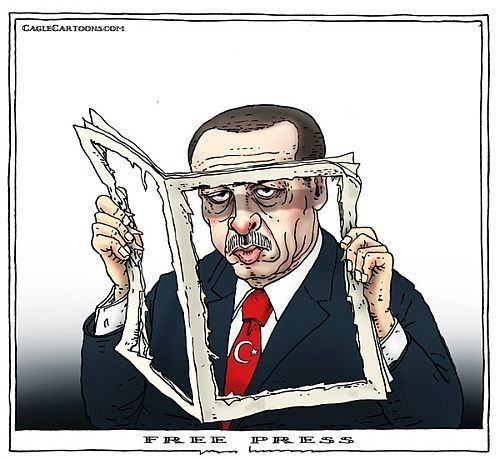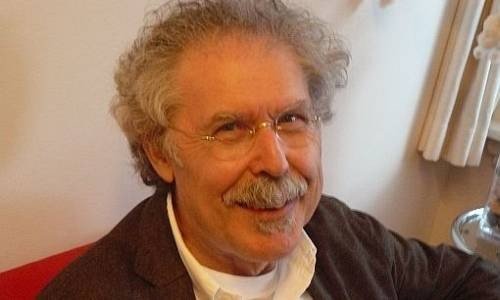A part of people in Turkey know caricaturist Joep Bertrams from the caricature which showed former PM Recep Tayyip Erdoğan as he was reading a hallow newspaper during 2013 Gezi Park protests.
Bertrams says “I was really proud of myself when I saw my caricature on Gezi banners” in order to describe mass protests in Taksim Square and on social media.
Bertrams who has been drawing for 40 years and lately has been drawing political cartoons tells: “We cannot trust an auto gallery owner when he says ‘It’s a new car but I don’t know its features’” and Bertrams adds he can’t lean towards Erdoğan because of Erdoğan’s attitude towards the ISIS, Islam and a lot of different subjects.
Bertrams who witnessed the situation of Turkey’s caricaturists in Festival van het Vrije Woord in Amsterdam De Balie that hosted Danish caricaturist Kurt Westergaard as special guest on 2nd May shared his ideas with bianet about Holland people and being an illustrator, relationship between Turkey and European Union and Turkey’s government.

When did you start to draw caricatures?
I started to draw political cartoons in the end of the 80’s in a very optimistic period when Soviet Russia had been in its last ten years and Holland had been living through both good and bad progress. Actually, it was September 11 Attacks that unsettled Holland People.
Until the year 2001, caricaturists especially were interested in problem between Israel and Palestine and most of the published caricatures were in Palestine’s favor. We were interested in relationship between Yassar Arafat and Ariel Sharon and meetings in Oslo that went on not badly at all. Just then, September 11 Attacks happened and Islam got into a jam.
Some political parties and organizations sent messages like “Muslims disturb our peace”. In the meantime, illustrators were more peaceful. However, some Muslim people in the community and some illiterate youngsters defended these kind of attacks as a reaction against the community they lived in and still continues to defend but social constructors are actually responsible from these. In the beginning of the 20th century, people in the community who wanted to work in Holland and didn’t want to read and write because they wanted to earn money had the same difficulties. In my opinion, this is not a problem related to Islam but it’s related to immigration as a social problem. For example, Surinamese people who were the first ones to immigrate to Holland had some serious difficulties but these problems have been solved majorly. On the other hand, Muslim people living in big cities were seen as the reasons of the attacks across Holland with September 11.
As an illustrator, our mission was to struggle the idea of seeing Muslims as a threat since they couldn’t adapt the community. Today we still struggle against these nonsense and exaggerated emotions from a cartoonist approach. Extreme rightist Holland Party for Freedom’s (PVV) leader Geert Wilders pulled his votes to 23% quickly with his anti-Islamic propaganda. He is so successful in this manner that he is loved by illiterate people who come from rural places and don’t know Muslims actually. They are a minority in Amsterdam but they are effective in touristic city, Volendam which’s in North of Amsterdam.
What kind of difficulties do caricaturists meet?
Actually, we can see the situation of the caricaturists in Turkey from Mehmet Ülger’s documentary (Bahadır Baruter says people who attack caricatures don’t even read them in doceumentary). These kind of people don’t read caricatures or newspaper. They just sit down on their coaches and watch TV shows. They don’t like caricatures. Even if I try so hard and draw, I cannot reach them. Never.
I reflect the community’s problems in my perspective in a simple and clear way without being a smart aleck like politicians but only with my curiosity.
You drew Tayyip Erdoğan. What are your observations on Turkey?
Turkey is a big country sharing the values of Europe with us. We already live with a lot of Turkish people. Turkey can be miles away but she is very near to me in terms of politics and living together.
Of course I am very curious about Tayyip Erdoğan’s approach and behaviors and how Turkey has become nonsecular throughout ten years. Actually great masses who don’t understand politics and don’t give freedom each other are great dangers. It shows us how we would be in Holland with extreme rightists. That’s why, Turkey’s situation affects me and my caricatures.
I drew Erdoğan during Gezi protests when mass protests in Taksim Square and on social media had been risen. At that time, a lot of my colleagues drew these kind of caricatures. I was really proud of myself when I saw my caricature on Gezi banners. I learnt that my caricature was censored after that. I was glad because I did a good job.
I feel Erdoğan’s attitude towards the ISIS, Islam and a lot of different subjects is very shadowy. I don’t like this. We cannot trust an auto gallery owner when he says ‘It’s a new car but I don’t know its features’.
What must be Turkey’s part in Islamic World?
How could you expect dialogue and negotiation in an insecure environment? As a caricaturist and a person who believes in freedom of expression, I can’t support this kind of conservatism.
In my opinion, each person has a right to express his/her ideas and belive or not to believe. This conservatism does not secure it. On the contrary, they follow their own beliefs, their own ideas and their own rules.
On the other hand, turkey has wanted to be a member of EU for ten years and expressed it openly but Europa rejected. I was criticizing that but nowadays they don’t want to participate in too much and it disappoints Europe. This is hypocrisy.
How is your relationship with caricaturists in Turkey?
Honestly, few of them know English so our relationship is a bit weak but via international press and our friends here for example Mehmet Ülker, we watch and follow their problems.
What are the problems Dutch illustrators face? Are they charged against?
Absolutely not. However, in the last months, a lawyer sued against the illustrator Ruben Oppenheimer with the claim that illustrator had said he was untrustworthy about him but as a result of freedom of expression, the illustrator was acquitted. This was a rare case.
We come together and converse about how newspapers are bad and in which way our sector goes as being caricaturists. We don’t talk about our cartoons but this is normal because we come from different political views. Some of us reflect a bit leftist media, other ones reflect a bit rightist media and this is how it works.
What’s the status of the caricaturists?
They work as a freelancer. They are paid per caricature. The number of the newspapers is decreasing and we have difficulty to find newspapers to work. That’s why, most of us work on the internet. Unfortunately, they cannot earn much.
I find it not helpful with regards to our job and quality. For instance, professional photographers take photos with their cameras but other people take photo with their iPhones. Media doesn’t care about that. They are like fast food restaurants.” Do you want it? So, take it!” This is no good for our job.
Are you pleased with your job? Do you get along?
I’m really happy to draw caricatures. I’ve started to create animations and present them. This helps me to tell my story in a broader way.
Who is Joep Bertrams?
Joep Bertrams was born in Roermond in 1946. He lives in Amsterdam. He graduated from La Hey Royal Academy of Arts. He started to draw in trade union’s magazine and kept on drawing and writing in child books in 1977. Bertrams started to draw political cartoons in international Het Parool daily newspaper in 1988. He has been drawing and creating political cartoons and animations for NOVA TV since 2004. He was awarded for his works in 1986, 1989, 2001 and 2005 (EÖ/BD)




